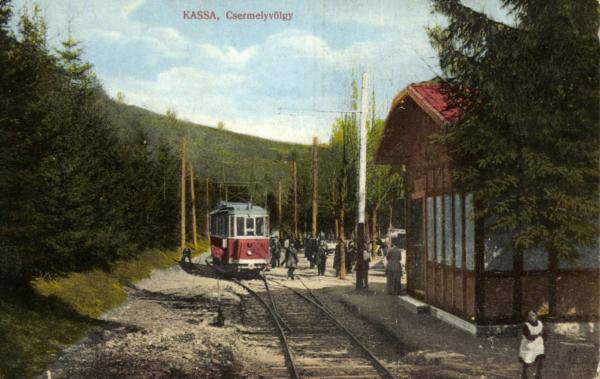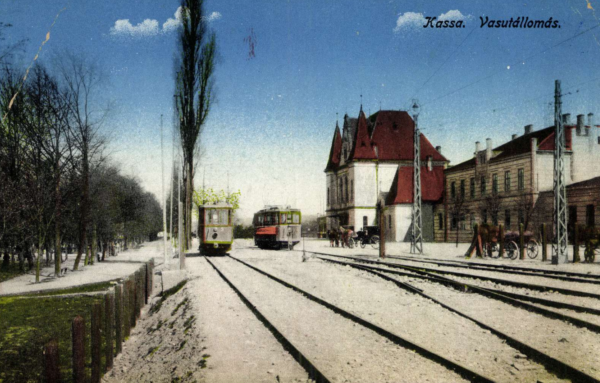Kassa-Torna local railway ltd

Article XXXI of 1880 made it possible to authorise and build railways for local traffic under light conditions. Another concession was that the railways were authorised by the government, not by Parliament. In addition, the operation of the lines of local interest could be transferred to other, larger railway companies, most often to the one to which the line of local interest was connected. By the 1880s, this was mostly MÁV.
This is how the Kosice-Tornava Local Interest Railway was created. The investors founded the joint-stock company with a total capital of HUF 1 073 500, for which they issued HUF 375 000 of ordinary shares and 969 200 preference shares. The 4,846 preference shares had a nominal value of HUF 200, while 1,800 of the preference shares for presentation were HUF 200 and 314 HUF 50.
The line was licensed by the Minister of Commerce on 26 December 1889 and opened on 12 October 1890. The licence holders were granted a licence until 1979, and the line was supposed to become public property after 90 years.
As it was a railway of local interest, the traffic was handled by MÁV. The railway started from the main line from the MÁV's Bárcza station near Kassa and, when fully developed, ran via Enyiczke, Nagy-Ida, Szepsi and Somodi to Torna. A further branch line, opened in 1894, ran from Szepsi to Metzenzéf, from Pocskaj to Lucziabánya and from Torna to Sajószentpéter. The total length of the line was 53.739 km, and when it opened, Košice had a railway line to all the surrounding valleys, which mainly served the iron industry in the area, connecting peelers, coal mines and iron ore mines. The railway was joined at its southern terminus by another HÉV line, which from 1904 provided another link between Miskolc and Kassa.
The line was sometimes very steep, the second steepest non-gear railway line of local interest, as it included a 27,000 gradient, the steepest being the Tarczavölgyi HÉV.
The company originally set up its headquarters in Kassa, but it soon became apparent that this was inappropriate, as the railway was operated by MÁV, which had its headquarters in Budapest. In 1892, a request was made to change the seat in the licence document. The administrative headquarters of the company was then moved to Budapest. The administrative language of the railway was Hungarian.
After Trianon, the Kassa-Torna line was annexed to Czechoslovakia, so the connection with the rest of the Hungarian railway line was severed. The design of the Trianon border often did not take into account local conditions on the railways. Not only were Hungarian interests not taken into account, but also those of the successor states. A good example is Bódvavendégi, where the railway serving the quarry opposite could only reach it by trains having to enter Hungary, whose railway connection could only be established by trains having to enter Hungarian territory via a short section.
On 12 January 1919, the Kassa Newspaper reported the news that the railway, one of the last local railways of local interest not yet nationalized, would be nationalized by the Czechoslovak state. In contrast, the details of the railway are still given in the 1925 Magyar Compass, with 25 Hold Street, Budapest, as its headquarters, and its share capital put at 5,012,000 crowns, although the prospectus notes that the railway was in Czechoslovak territory. In June 1932, the Kassa newspaper also wrote the following about the railway line:
"The Kassa-Tornava Railway Ltd. 1931 closed with a loss of 3.87 million crowns. In 1930 the loss was 3.77 million crowns. A dividend of 5 percent will again be paid from the reserve fund. The company owes the state 36.2 million crowns."
The joint-stock company did not cease to exist, but after the re-annexation of Košice, it moved its headquarters back to Budapest, where it remained for a time. It was only after the Second World War that the joint-stock company finally ceased to exist, the validity of the shares being annulled by the Budapest Court in 1947.
Points of interest
The builder of the Kassa-Torna line was a very famous engineer, Béla Gerster (1850-1923), who returned to Kassa in 1886. Béla Gerster was by then a well-known engineer in Hungary, having worked on projects such as the Ferenc Canal, which had been the responsibility of István Türr. However, Béla Gerster's name is also to be found on two internationally prominent projects of the time. One was the first survey of the Panama Canal route, which was started in István Türr's company, and the other was the construction of the Corinth Canal, for which Türr was also the chief engineer. His name is commemorated in a memorial at the canal.

Founded in 1890
Date of cessation: 1947
Founders: dr. Aurél Münnich
Securities issued:
| Kassa-Tornai local railway r.t. priority share. |
Decisive leaders:
1890-1904 | Dr. Aurél Münnich |
1905-1910 | Dr. József Stetina |
1911-1922 | Gusztáv Kálmén |
Main activity: railway services
Author: by Domonkos Csaba
Founded in 1890
Founders: dr. Aurél Münnich
Decisive leaders:
1890-1904 | Dr. Aurél Münnich |
1905-1910 | Dr. József Stetina |
1911-1922 | Gusztáv Kálmén |
Main activity: railway services
Main products are not set
Seats are not configured
Locations are not set
Main milestones are not set
Author: by Domonkos Csaba
Kassa-Torna local railway ltd

Article XXXI of 1880 made it possible to authorise and build railways for local traffic under light conditions. Another concession was that the railways were authorised by the government, not by Parliament. In addition, the operation of the lines of local interest could be transferred to other, larger railway companies, most often to the one to which the line of local interest was connected. By the 1880s, this was mostly MÁV.
This is how the Kosice-Tornava Local Interest Railway was created. The investors founded the joint-stock company with a total capital of HUF 1 073 500, for which they issued HUF 375 000 of ordinary shares and 969 200 preference shares. The 4,846 preference shares had a nominal value of HUF 200, while 1,800 of the preference shares for presentation were HUF 200 and 314 HUF 50.
The line was licensed by the Minister of Commerce on 26 December 1889 and opened on 12 October 1890. The licence holders were granted a licence until 1979, and the line was supposed to become public property after 90 years.
As it was a railway of local interest, the traffic was handled by MÁV. The railway started from the main line from the MÁV's Bárcza station near Kassa and, when fully developed, ran via Enyiczke, Nagy-Ida, Szepsi and Somodi to Torna. A further branch line, opened in 1894, ran from Szepsi to Metzenzéf, from Pocskaj to Lucziabánya and from Torna to Sajószentpéter. The total length of the line was 53.739 km, and when it opened, Košice had a railway line to all the surrounding valleys, which mainly served the iron industry in the area, connecting peelers, coal mines and iron ore mines. The railway was joined at its southern terminus by another HÉV line, which from 1904 provided another link between Miskolc and Kassa.
The line was sometimes very steep, the second steepest non-gear railway line of local interest, as it included a 27,000 gradient, the steepest being the Tarczavölgyi HÉV.
The company originally set up its headquarters in Kassa, but it soon became apparent that this was inappropriate, as the railway was operated by MÁV, which had its headquarters in Budapest. In 1892, a request was made to change the seat in the licence document. The administrative headquarters of the company was then moved to Budapest. The administrative language of the railway was Hungarian.
After Trianon, the Kassa-Torna line was annexed to Czechoslovakia, so the connection with the rest of the Hungarian railway line was severed. The design of the Trianon border often did not take into account local conditions on the railways. Not only were Hungarian interests not taken into account, but also those of the successor states. A good example is Bódvavendégi, where the railway serving the quarry opposite could only reach it by trains having to enter Hungary, whose railway connection could only be established by trains having to enter Hungarian territory via a short section.
On 12 January 1919, the Kassa Newspaper reported the news that the railway, one of the last local railways of local interest not yet nationalized, would be nationalized by the Czechoslovak state. In contrast, the details of the railway are still given in the 1925 Magyar Compass, with 25 Hold Street, Budapest, as its headquarters, and its share capital put at 5,012,000 crowns, although the prospectus notes that the railway was in Czechoslovak territory. In June 1932, the Kassa newspaper also wrote the following about the railway line:
"The Kassa-Tornava Railway Ltd. 1931 closed with a loss of 3.87 million crowns. In 1930 the loss was 3.77 million crowns. A dividend of 5 percent will again be paid from the reserve fund. The company owes the state 36.2 million crowns."
The joint-stock company did not cease to exist, but after the re-annexation of Košice, it moved its headquarters back to Budapest, where it remained for a time. It was only after the Second World War that the joint-stock company finally ceased to exist, the validity of the shares being annulled by the Budapest Court in 1947.
Points of interest
The builder of the Kassa-Torna line was a very famous engineer, Béla Gerster (1850-1923), who returned to Kassa in 1886. Béla Gerster was by then a well-known engineer in Hungary, having worked on projects such as the Ferenc Canal, which had been the responsibility of István Türr. However, Béla Gerster's name is also to be found on two internationally prominent projects of the time. One was the first survey of the Panama Canal route, which was started in István Türr's company, and the other was the construction of the Corinth Canal, for which Türr was also the chief engineer. His name is commemorated in a memorial at the canal.
